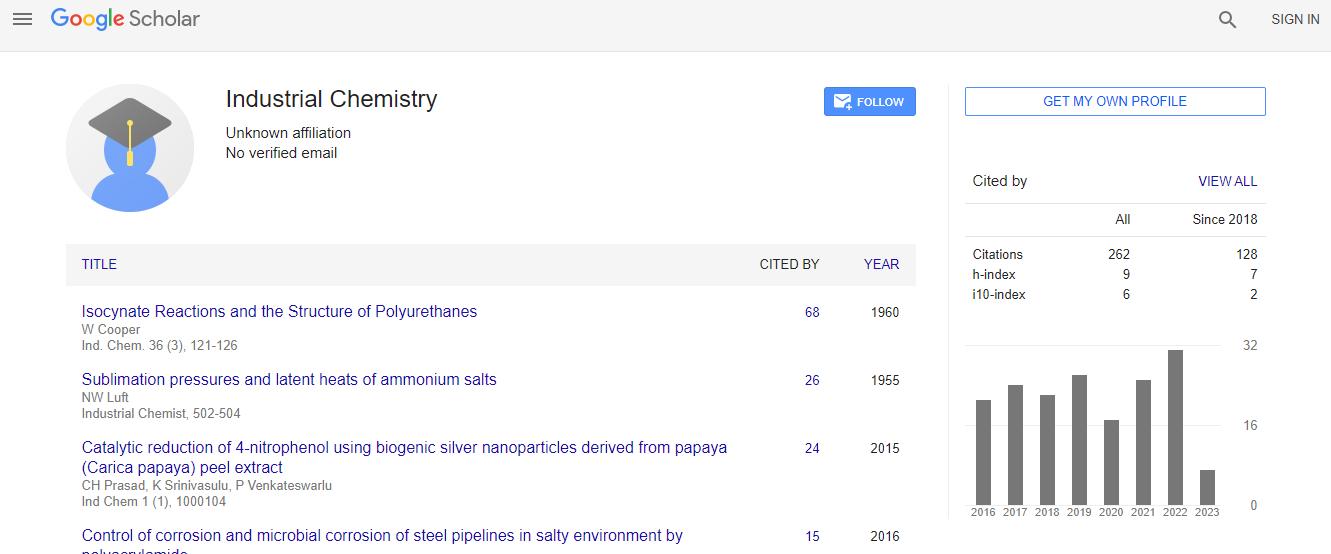Our Group organises 3000+ Global Conferenceseries Events every year across USA, Europe & Asia with support from 1000 more scientific Societies and Publishes 700+ Open Access Journals which contains over 50000 eminent personalities, reputed scientists as editorial board members.
Open Access Journals gaining more Readers and Citations
700 Journals and 15,000,000 Readers Each Journal is getting 25,000+ Readers
Google Scholar citation report
Citations : 262
Industrial Chemistry received 262 citations as per Google Scholar report
Indexed In
- Index Copernicus
- Google Scholar
- RefSeek
- Directory of Research Journal Indexing (DRJI)
- Hamdard University
- EBSCO A-Z
- OCLC- WorldCat
- Scholarsteer
- Geneva Foundation for Medical Education and Research
- Euro Pub
Useful Links
Recommended Journals
Related Subjects
Share This Page
Hybrid water treatment process of alumina ceramic ultrafiltration and PP beads with air backflushing: Effect of pH and polypropylene beads
2nd World Conference on Industrial Chemistry and Water Treatment
Jin Yong Park and Soojung Lee
Hallym University, South Korea
ScientificTracks Abstracts: Ind Chem
Abstract
For advanced water treatment, effects of pH and pure PP beads packing concentration on membrane fouling and treatment efficiency were observed in a hybrid process of alumina ceramic MF and pure PP beads. The tubular UF membrane (NCMT-5231) with pore size 0.05 �¼m was manufactured by �±-alumina in nanopore materials. The diameter of PP beads was 4-6 mm, and the synthetic feed was prepared with humic acid and kaolin. The synthetic feed was allowed to flow inside the MF membrane and the permeated contacted the PP beads fluidized in the gap of the membrane and the acryl module case with outside UV irradiation. Periodic air back-flushing was performed to control membrane fouling during 10 sec (BT, backflushing time) per 10 min (FT, filtration time). These results were compared with the previous studies. The membrane fouling resistance (Rf) was minimum at 50 g/L of PP beads concentration. Finally the maximum total permeate volume (VT) was acquired at 50 g/L of PP beads. It means that the membrane fouling could be controlled by PP beads at 50 g/L. The treatment efficiency of turbidity decreased slightly from 99.4-99.0% as PP beads concentration decrease; however, that of dissolved organic materials (DOM) decreased dramatically from 87.8-73.9% as decreasing PP beads concentration. It means that more PP beads could adsorb or photo-oxidize DOM more effectively. The Rf increased as increasing pH of feed as compared and the maximum VT was acquired at pH 5.1. It means that the membrane fouling could be inhibited at low acid condition. The treatment efficiency of turbidity was almost constant independent of pH; however, that of DOM was the maximum at pH 6.5. It means that the DOM could be removed more excellently at the low alkali condition.Biography
Jin Yong Park has his expertise in membrane separation technology for water or wastewater treatment at Department of Environmental Science and Biotechnology, Hallym University, Korea. Recently, he has researched the hybrid water treatment process of ceramic membrane and polymer beads coated with photocatalyst. He was involved in the projects of artificial kidney and reverse osmosis for drinking water as Research Scientist in Membrane Laboratory, KIST, Korea and developed the group contribution method to predict the permeability of gas separation polymer membranes as a Postdoctoral Fellow at Centre for Polymer Research, University of Texas at Austin, USA. He has worked as a Visiting Professor at the Department of Civil and Environmental Engineering, UCLA, USA. He has performed more than 40 projects and has published 70 articles related to membrane technology including 20 articles in SCI journals. Also, he has worked as General Affairs Director, Editor-In-Chief and Executive Director in the Membrane Society of Korea.
Email: jypark@hallym.ac.kr

 Spanish
Spanish  Chinese
Chinese  Russian
Russian  German
German  French
French  Japanese
Japanese  Portuguese
Portuguese  Hindi
Hindi 